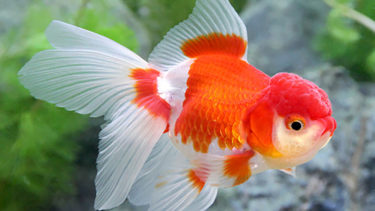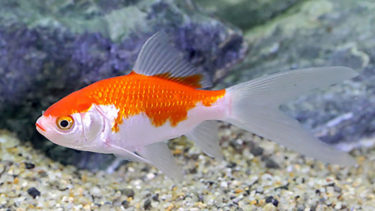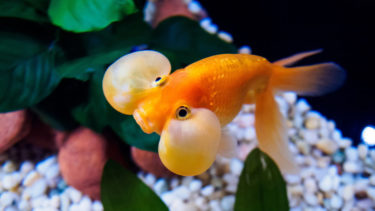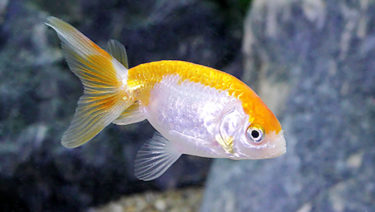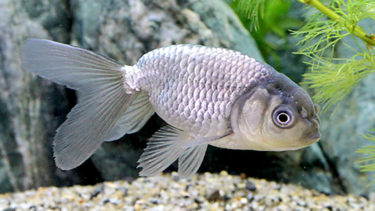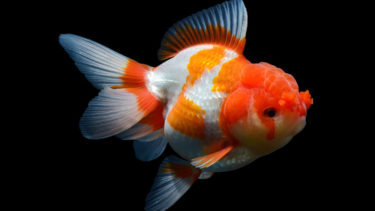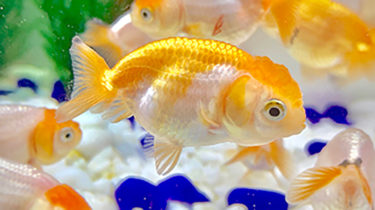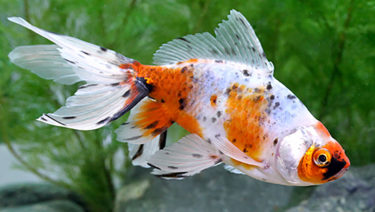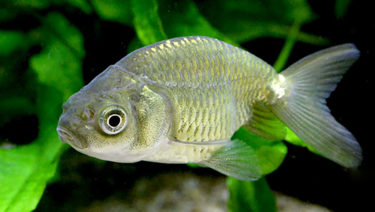The Hana without a dorsal fin is born from a cross between the dorsal finless Dutch Shishigashira and the Osaka Ranchu, and as it grows, it becomes a smart and beautiful goldfish with a longer caudal fin. In this article, we would like to explain in detail the characteristics and how to keep the Hana no Kohana.
What is Flowers Without Words?

The Arachama no Hana is a goldfish born from the cross between the dorsal-finless Dutch Shishigashira and the Osaka Ranchu.It is still a developing breed as it has only just been born. As it grows, the flesh mass does not grow much and the tail fin becomes longer, making it a smart and beautiful goldfish like the Comet. The name of the Hana without clothes itself is not well known because it is a relatively new breed and there are only a few of them on the market. In books and on other websites, it is sometimes referred to as the "Flower without a coat of arms. In this site, we use "ara-tama-no-hana" instead.
The orchid lionhead is a goldfish characterized by its caudal fin and head mass. It is a goldfish that can be kept in a variety of ways depending on its body color, the size of the fleshy mass on its head, and the way its tail fin spreads. In this article, we would like to explain in detail the characteristics of the Woran Shishigashira and how to keep it. What is the Woran lionfish [...]
The Osaka Ranchu is one of the oldest classified goldfish in the Ranchu lineage, having its roots in the Maruko (Maruko) as well as the Ranchu and Nankin varieties. In this article, we would like to explain in detail the characteristics of the Osaka Ranchu and how to keep it. What is the Osaka Ranchu [...]?
The comet is a goldfish imported from the United States. The comet is a very beautiful goldfish with a slender, elongated head to the tip of its tail fin. In this article, we would like to explain in detail the characteristics of the Comet and how to keep it. What is the comet? The comet is a Japanese [...]
The origins of the flower without care
The "Flowers without clothes" were created around 1998 by Mr. Shizuo Isobe of Hamakita, Hamamatsu City, Shizuoka Prefecture. The name of the place where Mr. Isobe lived at that time was called Aramatama Village, so he named it "Flowers without Words" in the hope that it would be a local goldfish born in a place he was very attached to.The original Flowers without clothes was a hybrid of Holland Shigashira and Osaka Ranchu, but unfortunately, no offspring were able to be produced. Unfortunately, he was not able to find any offspring after that, and the current Flowers without Words is a hybrid of Osaka Ranchu and a descendant of Comet, which he received from Mr. Goro Ikeyama, who lives in Hamamatsu City.
Many people think that goldfish are the goldfish that you see at fairs and festivals in the summer, and that there are many different kinds of goldfish. And it is no exaggeration to say that each type of goldfish has its own characteristics, and that is the best part about goldfish [...]
How to Enjoy Flowers without Worries
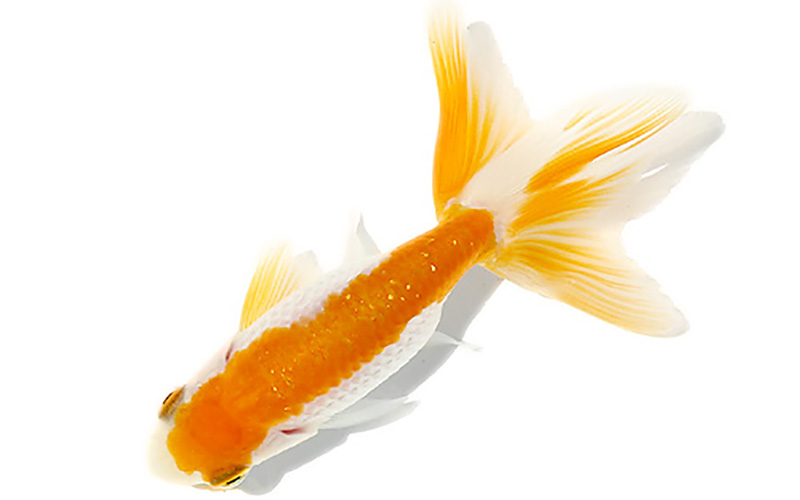
Unlike the Ranchu lineage, the way to enjoy the flower of the flower is not to enjoy its fleshy mass, but to enjoy its long and beautiful tail fin, which is slender from the tip of the head to the caudal fin. If you want to enjoy them, it is recommended to view them from the side (side view) in an aquarium.By viewing it from the side, you can enjoy the beauty of its dorsal finless back and beautifully elongated tail fin, which are characteristics of the Ranchu lineage, and also appreciate the unique beauty of the flower without any flesh mass, which is different from the Ranchu lineage. If you look at it from the top, you can observe its slender and straight body shape, and if you enjoy the side view to the fullest, you can enjoy it from a different angle by looking at it from the top.
Points to keep in mind when mixing swimmers
When mixing goldfish with other goldfish and other species, there is sometimes uncertainty as to what species is good and what species is not. First,There is no general prohibition against this or that when mixing goldfish with other species.Therefore, depending on the personality and environment of the goldfish you keep, even species that are said to be bad for each other may get along well with each other. However, there is also the matter of compatibility between goldfish. If you put incompatible goldfish together, there is a high possibility that they will fight or that only one of them will monopolize the food. However, as explained in the beginning, there is no prohibition for goldfish, so if you want to mix them, it may be OK to do so. Now, let us explain which goldfish are compatible with Japanese goldfish and which are not.
Compatible goldfish
The goldfish that are most compatible with the 麁 no Hana are Ranchu-type goldfish, such as Ranchu and Edonishiki.Since the Ranunculaceae variety does not have a well-developed head mass, it is recommended to put it in with the Ranchu type goldfish so that it is very easy to see the differences and compare the characteristics of each species.
About Ranchu
About Edo Nishiki
About Ranchu Type
Incompatible goldfish
Goldfish that are incompatible with the Wagarin flower are Wagin (Japanese goldfish), comets, and other Wagin-type goldfish.Many types of Japanese goldfish are agile and grow large in a short period of time. If they are mixed with Japanese goldfish, please be aware that the flower without clothes may be eaten by other Japanese goldfish and the difference in body size may cause them to move apart.
About WAKIN
About Comet
About Us
What to keep in mind when keeping a flower without care
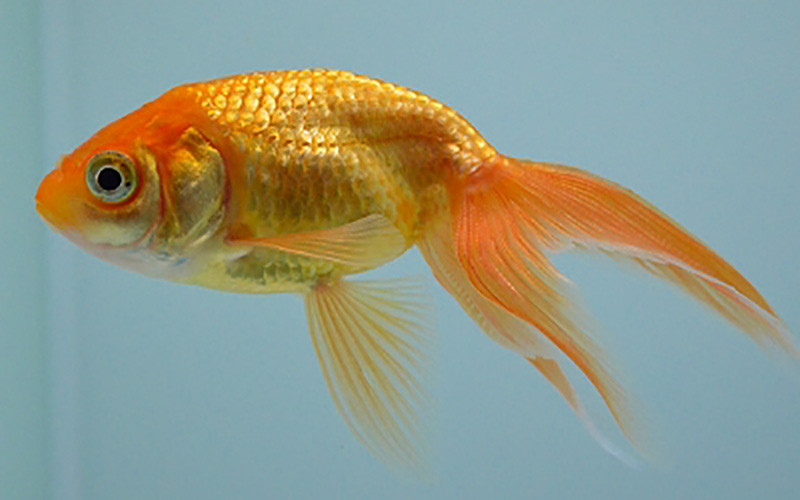
The Hana without clothes is a variety of goldfish that has characteristics of both the Holland Shishigashira strain and the Ranchu strain, and has a unique character that no other goldfish has. The most important feature is its beautiful form. The most interesting thing about the Hana without clothes is that it is not yet in its finished form.This is a breed that will continue to evolve in the future, so if you are interested in seeing what kind of goldfish it will become, please try breeding it. If you find one, it is worthwhile just to observe it and learn about its beauty.


